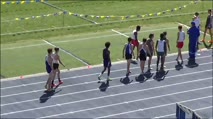
Tanner Norman's 1600 and 3200 marks this spring not only took down a long-standing state record, but also helped make this a solid year for elite boys distance marks.
Yesterday, we looked at trend lines for high school cross country times here in Colorado. Today, I take a very similar approach to track and field times for 1600 and 3200 meters.
Like yesterday's article, this article will limit itself to times achieved at meets here in Colorado, so that we don't have to worry about sorting out sea-level kind of performances from altitude performances where the same times are much more difficult to achieve.
For girls, I selected 1600 times of sub-5 and sub-5:20 as the thresholds of interest. I selected 3200 times of sub-11 and sub-12 as the thresholds of interest.
For boys, I tried to select times that would yield groups of similar sizes. That mean sub-4:20 and sub-4:40 for 1600s and sub-9:30 and sub-10:10 for 3200s. I tend to think of 5, 11, 4:20, and 9:30 as elite standards that very few athletes will meet, but 5:20, 12, 4:40, and 10:10 are high, but attainable, standards that are within reach of a large percentage of distance runners.
At this point, it's probably best to show you the data, then engage in discussion following the data tables:
Girls 1600s and 3200s
| Year |
Sub-5 Girls |
Sub-5:20 Girls |
Sub-11 Girls |
Sub-12 Girls |
| 2009 |
4 |
61 |
5 |
52 |
| 2010 |
2 |
79 |
2 |
67 |
| 2011 |
2 |
82 |
2 |
69 |
| 2012 |
3 |
104 |
1 |
72 |
| 2013 |
3 |
108 |
10 |
84 |
| 2014 |
9 |
103 |
6 |
78 |
| 2015 |
3 |
89 |
6 |
86 |
| 2016 |
4 |
103 |
5 |
91 |
| 2017 |
3 |
131 |
5 |
103 |
Boys 1600s and 3200s
| Year |
Sub-4:20 Boys |
Sub-4:40 Boys |
Sub-9:30 Boys |
Sub-10:10 Boys |
| 2009 |
6 |
87 |
11 |
60 |
| 2010 |
4 |
99 |
7 |
72 |
| 2011 |
7 |
91 |
8 |
73 |
| 2012 |
5 |
124 |
3 |
86 |
| 2013 |
3 |
131 |
3 |
94 |
| 2014 |
7 |
136 |
8 |
103 |
| 2015 |
6 |
135 |
5 |
108 |
| 2016 |
3 |
143 |
7 |
105 |
| 2017 |
6 |
160 |
7 |
129 |
I didn't try to incorporate track and field participation numbers into these tables because there is no reliable formula that calculates the proportion of distance runners out of the overall track and field participation total. So, participation counts aren't very useful here. That said, we would expect a slow increase over the years of athletes meeting each of the standards above as Colorado's high school age population increases over time.
What we see above, however, are steady rates of growth at the sub-5:20, sub-12, sub-4:40, and sub-10:10 thresholds that outstrip the rate of overall population growth.
The boys rate of growth is steadier (less saw-toothed) that the girls at both thresholds, but both tables show steady growth--at least at the less ambitious thresholds for each event and gender.
The more ambitious thresholds for both boys and girls at 1600 and 3200 meters show no particular trends except to say that we are getting more sub-11 3200s overall than we were as recently as 2009. And, clearly, 2009 was an exceptional year for elite marks in the boys 3200.
The trends stand in contrast to what we saw with cross country, at least for girls. The rate of boys achieving sub-4:40 and sub-10:10 times in the 3200 corresponds fairly well with the rate of boys achieving sub-17 times in cross country. We qualify that, though, by saying there has been real growth in the number of boys achieving these standards over the last four years that isn't as evident with the cross country standard of 17 minutes.
Girls, on the other hand, show real and continued growth in the numbers hitting sub-5:20 and sub-12 minutes that contrasts with a decline in the number of girls hitting sub-20 in cross country.
I confess I'm at a total loss to explain why those trend lines would be pointed in opposite directions. But, if we're going to understand where we are and what forces are behind what we're seeing, we can ill afford to ignore data the seem to send conflicting messages.
Once again, I'm open to suggestions of how to interpret the data. You're welcome to join the conversation on this
forum thread. It's possible to comment below, of course, but going to the forum thread helps keep the conversation accessible in the same place for all.






